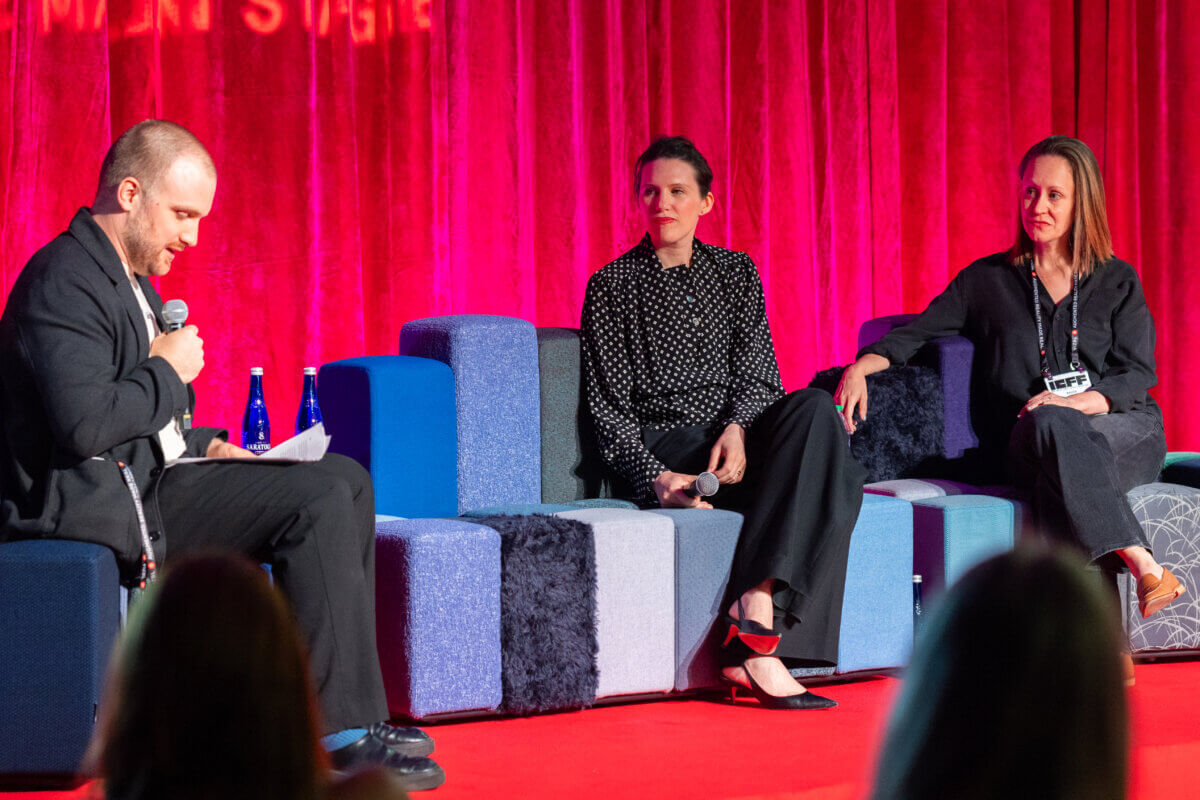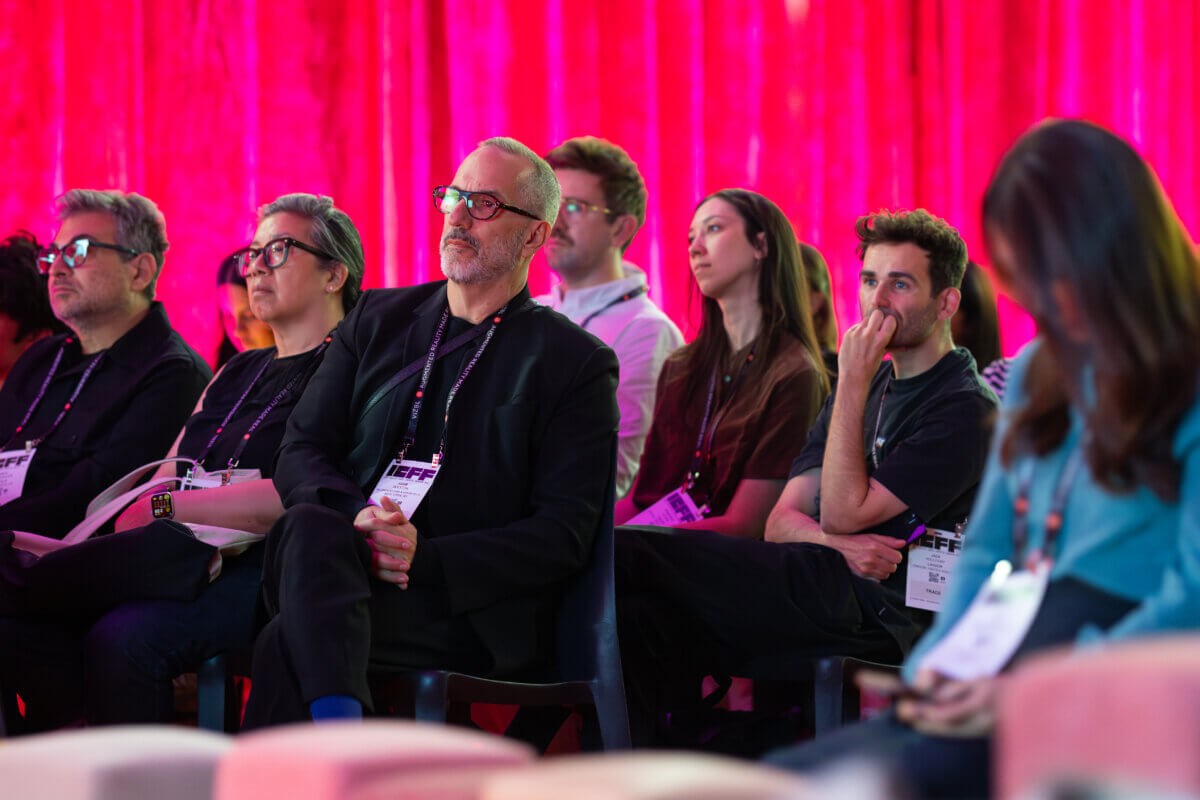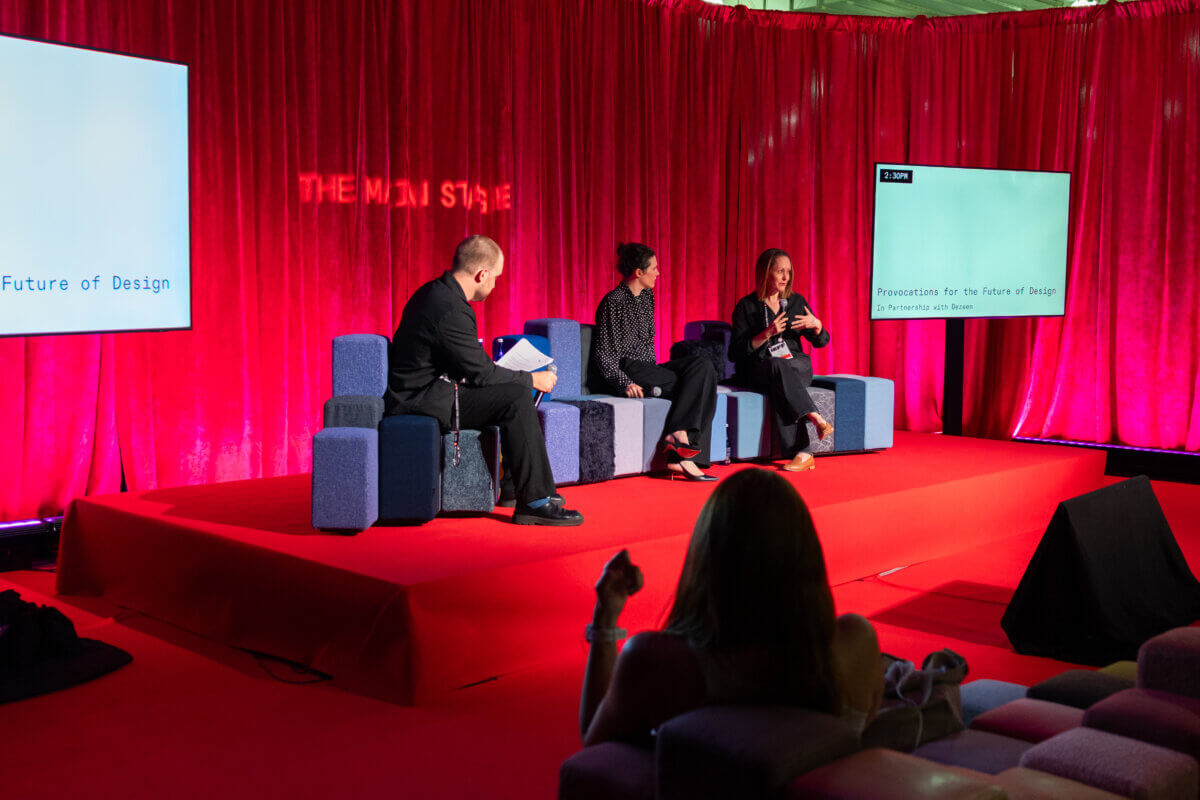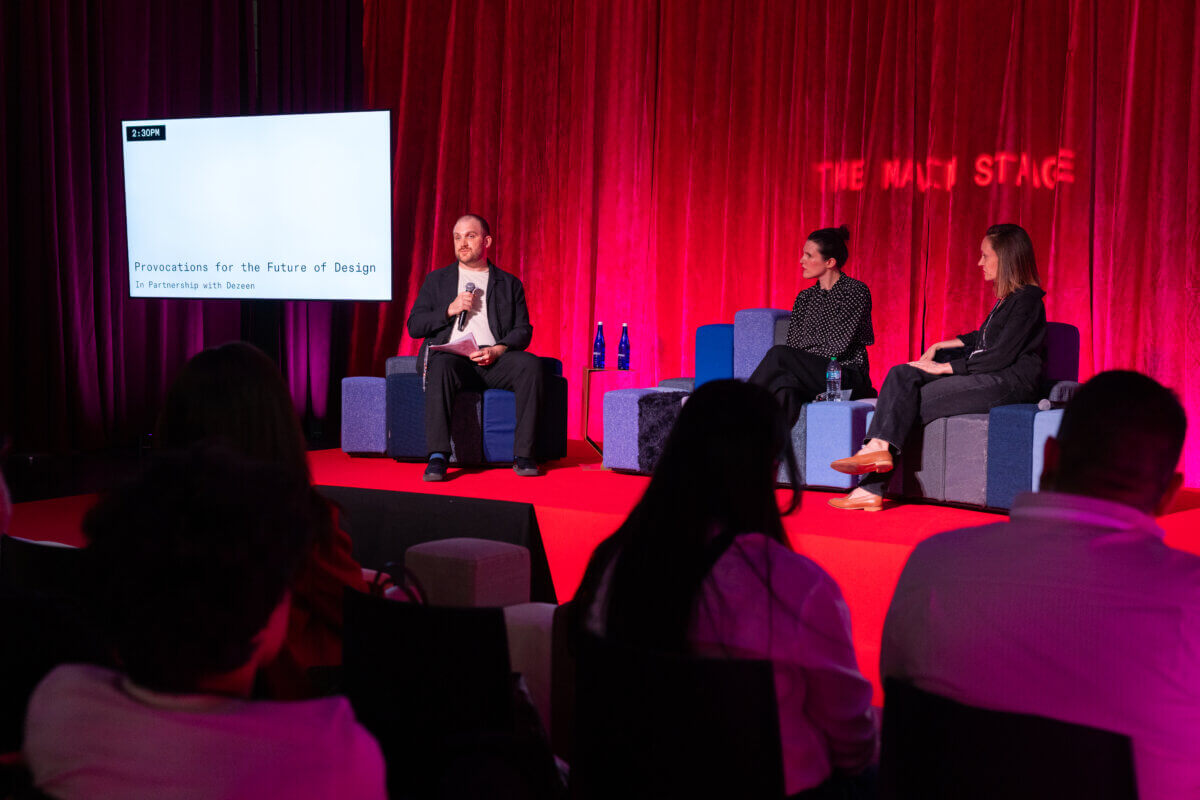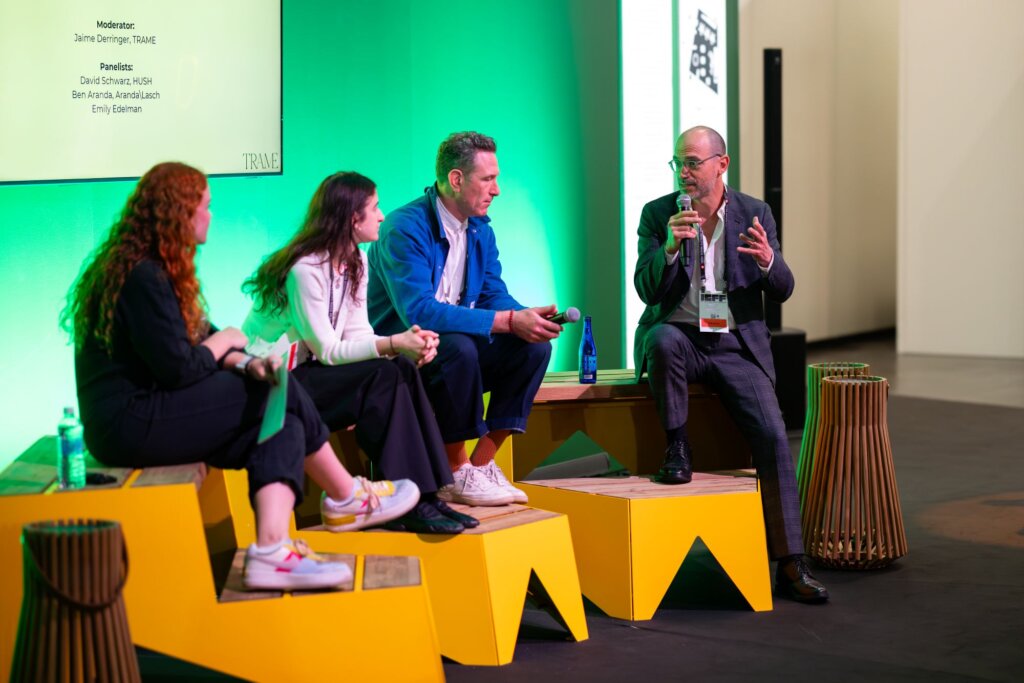
At this year’s ICFF, leading online design publication Dezeen hosted the “Provocations for the Future of Design” panel. U.S. editor Ben Dreith guided a conversation about the larger implications of contemporary design with insightful perspectives from renowned curator Beatrice Galilee (founder of the annual World Around Summit) and widely recognized cultural historian Maggie Gram (head of design, security command at Google and the author of the recently released book The Invention of Design). The discussion helped contextualize the new and revisited ideas being addressed at the fair and to a certain extent, took to task an industry that sometimes seems preoccupied with style and nothing else.
Dreith loosely framed the talk around three topics: what good design actually entails in a time when profits and trends are the prevailing forces driving the market; how design can actually be used to addressed ‘wicked problems’ such as unsustainable extraction and production; and how the discipline—as praxis (putting theory into action)—can inform the nature of political discourse. Ultimately, the conversation centered on the idea of guiding the broader domain toward a more sustained pace of progress.

Dezeen's U.S. editor, Ben Dreith, hosting the Provocations for the Future of Design Talk at ICFF 2025, photo credit: Jenna Bascom Photography
“Today, we are going to have a wide ranging conversation about the ways architecture and design are being carried out in and outside of institutions,” Dreith said. “We will explore what role these disciplines can play in the constant push and pull of innovation and consumerism and the ways that practitioners can play a role in opening up some of the innovations happening outside of the normal purview, such as in biotech and infrastructure. Today, so much public facing design is a beauty contest but there’s much more to it.”
Dreith cited influential 20th-century brand consultant Walter Landor’s seminal quote, “products are made in factories, brands are created in the mind.” The moderator expressed that this difference has become even more evident in recent decades. In some respect, design has moved away from the principles of fostering collaboration and “probing:” solving issues and focusing on “human centeredness.” There’s less and less preoccupation with what is increasingly being viewed as a polycrisis: environmental degradation, political disenfranchisement, and social inequity.
Dreith then mentioned that during the COVID-19 pandemic, most people were glued to their computer screens tracking the charts of infection and death rates. “The world was being held together by one underpaid infographic designer,” he said. “I’m interested in this aspect of design, not only as something we’re using, but something to help us understand the things that we’re using, especially as design has gotten so large scale, so small scale. I’m interested in how the design can be used to build institutions that connect us back together.”
After introducing the two panelists, the moderator asked Gram to elaborate on an idea extrapolated in the book: that business has long implemented the notion of design as a cultural tool; monopolizing the notion of innovation.
“In doing the research for my book, I was inspired by the research and writing of economist Mariana Matsudo,” Gram said. “In her 2013 book The Entrepreneurial State, she makes the argument that we attribute too much of the good that comes from innovation to the private sector. In fact, much of the scientific knowledge and breakthroughs of the 20th century, much of biotech, et cetera, can all be attributed to state funding and public private partnerships.”
A good example of this, for her, is online climate resource Project Drawdown: having developed a series of scalable open-source algorithms to address various problems. The initiative brings together a wide array of private, public, institutional and non-institutional stakeholders.
Dreith then suggested that what Galilee achieves within the framework of The World Around—a lecture as much as a workshop and awards program—is another great demonstration of what Gram was describing. “We’re a small nonprofit without walls or a building,” she said. “As a curatorial think tank for the Guggenheim, MoMA, Design Museum in London, or Shanghai Power Station, we’re a platform for the conversations that are hard for larger institutions to have because they’re so big and don’t have the ability to be nimble and reactive.”
She then went on to talk about how The World Around Young Climate Prize mentorship program connects experts with up-and-coming creatives—from primarily the global south, who are most impacted by climate change but contribute to it the least. The initiative focuses much more on the transference of knowledge than funds.
Dreith expanded on the notion that smaller organizations are agile by bringing up the importance of values: how in larger institutions, it’s often hard to shift these tenets especially when it comes to moving away from short-termism and unnecessary mass production. Contextualization—addressing a problem within the immediacy of a specific place rather than from a 360 view—is a central argument in Gram’s The Invention of Design. “When someone from London is working with someone from central Africa, how do you find common ground in lining up values? How do you supersede global divides? Do environmental issues transcend these differences?”
Galilee responded that finding those points of mutual understanding is a design problem in and of itself. Over the years, there have been challenges in bridging the gulfs between the 25 mentees The World Around has brought into the fold and their mentors. “We’ve had to think carefully about how we program and ‘designed’ this program but when the exchange worked it was transformative,” she said.
One example she cited was of a Belgian curator helping an up-and-coming Kenyan inventor—having developed a new bioplastic—create convincing pitch decks. In early May, major delivery service company DHL approached the designer to see if there could be a way to scale up his discovery and implement it in packaging. She also highlighted how the program has become a network and how former participants stay in touch to share resources. “These inventions don’t come from the global north, it came from where it’s needed most,” Galilee added.
The moderator probed a bit further and asked what can be done to keep such a large, often inflexible, multinational company at it; ensure that they don’t lose interest in such an initiative. Gram responded: “In the book, I explored how ethnography and research in general comes into the equation of product development.” She explained how companies such as Xerox have implemented departments for this aim in the past but ultimately disbanded them because they don’t directly contribute to the bottom line. Even at influential design firm IDEO, Gram has observed a similar limitedness in the valuation of this type of investigation. The issue remains the same: who’s paying the bills. Great, simple, and communication solutions have been developed but to what ends.
“I don’t necessarily think that it’s a problem with the methods, a problem with ethnographic methods in design or a problem with human-centered design, whatever it might be,” she added. “I do think that we tend to associate these things with the unadulterated good, and really they are only as good as their motivating contexts and their budgets or their funding sources.”
Dreith then brought up the issue of how top-down models of control rarely work well in solving problems or implementing viable solutions. Gram highlighting the writing of fellow theorist Sarah Hendren and rethinking the notion of accessibility and participation in design; challenging as well the nature of anthropological research. “It’s about empowering the participants in design research who might, in some other contexts, be called subjects to take the tools of the discipline and create extremely small-scale solutions to whatever problems they find most important,” she explained. “This is obviously something that’s a lot easier to do in academia than in a corporate context.”
The next topic addressed: AI and its correlation to accessibility, especially in attaining tools and information outside of institutions. “In my work with the Young Climate Prize, it’s become so clear how many barriers there are to centering the design industry and the benefits of overcoming those barriers are for everyone,” Galilee said. “The more access we have to the design and ideas of young people from all over the world who did not go to major universities or are not lucky enough to be here at these types of events, the more we knock down those barriers and the better it is for everybody. AI, whether it’s like Chat GBT or whether it’s just access in other ways, knocks down many of those barriers.”
More from ICFF:
ICFF 2025 Highlights: Creativity, Innovation and Connection in NYC
Original Thinkers: Designing with Purpose, Passion, and Integrity
Save the date for ICFF 2026, May 17-19, 2026
The talk concluded with the question of how within the specter of technological innovation, problem solving often clashes with beautification. “I think we see this tension in AI a lot,” the moderator noted. “It’s being used to sell, which is fine in some contexts, but I think that there has been a trend of designed products being swept away by that impulse and then maybe the original impulse—the plot—is lost.”
“These new tools are really good at making dashboards that look nice,” Gram responded. “They’re a lot less good at asking really good questions to identify the problem and make sure you’re solving the right one, figuring out all of the different pieces that need to be put together to do so effectively. I think we see that these tools are good at making things pretty but less good at doing the hardest human work. What I’m most worried about is that they are becoming really good at such a wide range of things. AI agents are becoming extraordinary replacements for human workers in lots and lots of cases. We really don’t know what the future looks like.” For her the human element needs to be safeguarded so that design remains for our benefit. Guardrails should be put in place so that the discipline is still reflective of our intention and collective interest.
The floor was then opened up to audience questions: everything from what role designers can do to have a better impact beyond areas like material research to how young people in the global north can engage in the same way the recipients of the The World Around Climate Prize are to the pressing issues of the day. A last comment brought up the question of interdisciplinarity and what that approach affords in terms of being more agile and future proof in the context of design.
More from ICFF:
ICFF 2025 Highlights: Creativity, Innovation and Connection in NYC
Original Thinkers: Designing with Purpose, Passion, and Integrity
Save the date for ICFF 2026, May 17-19, 2026!
